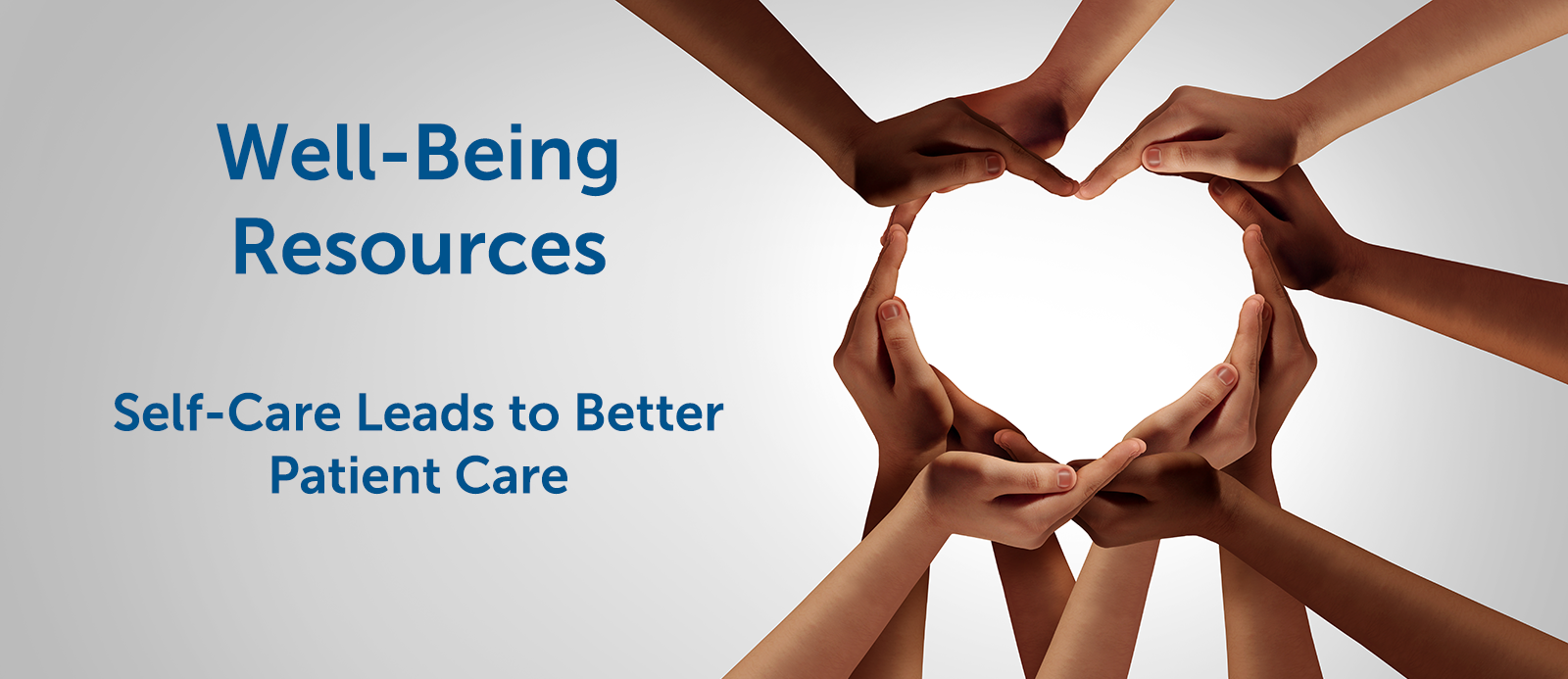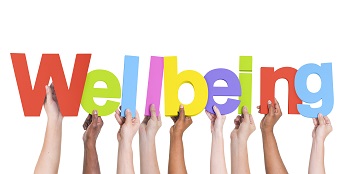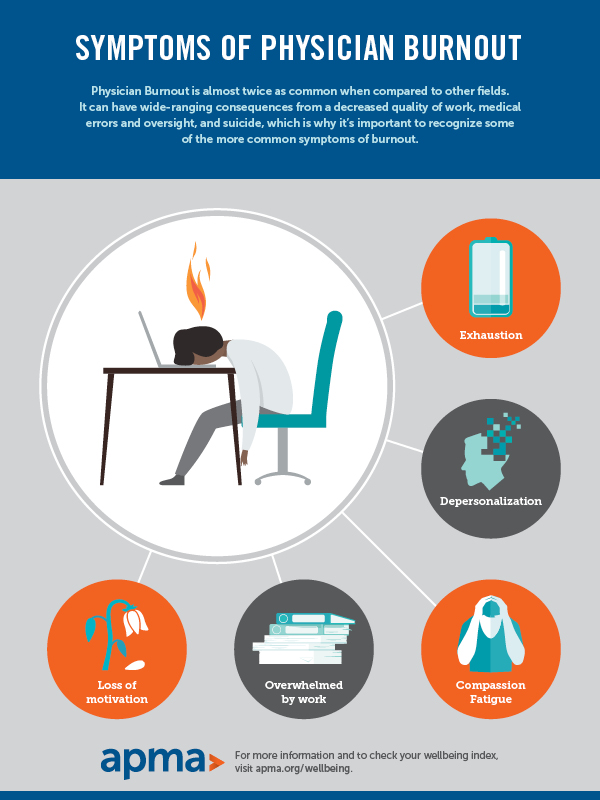Resiliency and Wellness
AAMC News: Building a Framework for Clinician Well-Being and Resilience and APMA's Statement of Support
The American Podiatric Medical Association and National Academy of Medicine members commit to collaboration while combating clinician burnout not only through identification of evidence-based effective ways to alleviate factors of physician burnout, but by effecting delivery of these means with immediacy. Physician burnout is contributing to an American health-care crisis from an increasing shortage of physicians.
Ending Physician Burnout: It’s Time for Physicians to Take Back Control of Their Environment and How They Deliver Care
This article by Bridget Duffy, MD, chief medical officer at Vocera, discusses the importance of physician well-being and how streamlined technologies can help mitigate physician burnout.
Federation of State Medical Boards: Physician Wellness and Burnout
The report and recommendations of the Workgroup on Physician Wellness and Burnout of the Federation of State Medical Boards approach physician wellness and burnout from a non-punitive perspective to advance a positive cultural change that reduces the stigma among and about physicians seeking treatment for mental, behavioral, physical, or other medical needs of their own.
Medscape National Physician Burnout & Depression Report 2018
Medscape’s National Physician Burnout & Depression Report describes the variety of factors that contribute to physician burnout.
New England Journal of Medicine Perspective: To Care Is Human
"To Care is Human—Collectively Confronting the Clinician-Burnout Crisis" tackles four central goals: increasing the visibility of clinician stress and burnout; improving health-care organizations’ baseline understanding of the challenges to clinician well-being; identifying evidence-based solutions; and monitoring the effectiveness of implementation of these solutions.
ScienceDaily Medical Errors and Physician Burnout Article
This article, "Medical errors may stem more from physician burnout than unsafe health care settings," links physician burnout to medical error, and reports on the national epidemic of high burnout linked to suicide.
STAT Moral Injury Article
This article, "Physicians aren’t 'burning out.' They’re suffering from moral injury," identifies physician burnout as a symptom of the broken health-care system, resulting in moral injury as physicians are forced to go against their will to provide high-quality care.
Mental Health, Substance Abuse, and Suicide Prevention
AAMC News: When Physicians Become Patients
This article reflects a call to action from Darrell G. Kirch, MD, president and CEO of AAMC. As a psychiatrist, he has treated physicians for burnout, depression, and suicidal ideation. He discusses the upward trend of this ideation and its toll, which is not only personal, but also professional, affecting patient care.
AMA Model Bill: Physician Health Programs Act
This act was created to allow for early identification of physicians with potentially impairing conditions (e.g., substance abuse, mental health, medical disease), in order to provide them with access to professional resources and support.
Medscape Article: Physicians Experience Highest Suicide Rate of Any Profession
The alarming one-per-day completed-suicide rate among physicians, residents, and medical students (28–40/100,00, double the rate of the general population), is driven mainly by the stigma within this group related to seeking professional help for depression, alcoholism, and treatable mental disorders. Growing awareness of this problem has allowed for implementation of initiatives to prevent physician suicide. Open discussions allow physicians, residents, and medical students to view suicide as an illness that needs treatment in an effort to shed the stigma that is acting as a major obstacle to seeking professional care.
Medscape Article: Resident Suicide: A Tragedy, and What Can Help?
A brief discussion of burnout among residents and medical students.
Medscape Article: Study Identifies Risk Factors for Physician Suicide
Several risk factors for suicide among healthcare professionals are identified, including age.
NIMH Answers Questions About Suicide
This fact sheet answers some common questions about suicide and suicide prevention among teens and young adults. The NIMH also provides digital resources to spread the word about suicide prevention.
Suicide in America Frequently Asked Questions
This NIMH brochure covers suicide risk in people of all genders and age groups.
Warning Signs of Suicide
This NIMH infographic presents behaviors and feelings that may be warnings signs that someone is thinking about suicide.
5 Action Steps for Helping Someone in Emotional Pain
This NIMH infographic presents five steps for helping someone in emotional pain in order to prevent suicide.
Preventing Suicide
This Centers for Disease Control and Prevention (CDC) fact sheet highlights the public health impact of suicide and strategies to prevent suicide. The CDC also provides A Technical Package of Policy, Programs, and Practices for communities and states.
The Suicide Prevention Resource Center (SPRC) is the only federally supported resource center devoted to advancing the implementation of the National Strategy for Suicide Prevention. SPRC is funded by the U.S. Department of Health and Human Services’ Substance Abuse and Mental Health Services Administration (SAMHSA).
The US National Library of Medicine provides information about suicide.
The National Action Alliance for Suicide Prevention is a public-private partnership that is advancing the national strategy for suicide prevention.
#BeThe1To is the National Suicide Prevention Lifeline’s message for National Suicide Prevention Month and beyond.
Ask Suicide-Screening Questions (ASQ) is a free screening resource for medical settings (e.g., emergency departments, inpatient medical/surgical units, outpatient clinics/primary care) that can help successfully identify youth at risk for suicide.





